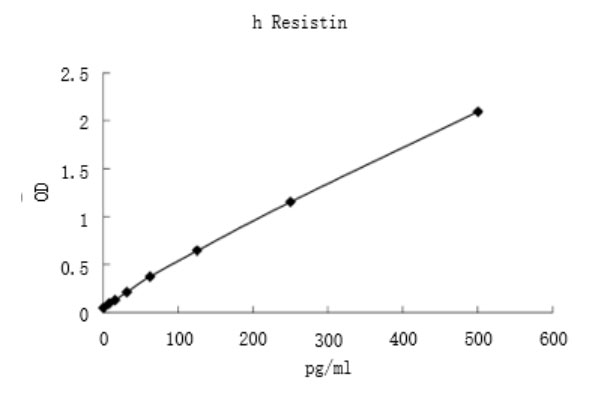Resistin, also known as Found In Inflammatory Zone 3 (FIZZ3) or Adipocyte Secreted Factor(ADSF), is a member of a protein family known as the Resistin-like molecules (RELMs). It is perhaps best known for its potential as a link between obesity and the development of insulin resistance (1). Other members of this family include RELM-α/FIZZ1 and RELM-γ, which are described in rodents but as yet have no identified human counterparts, and RELM-β/FIZZ2(2, 3). The Resistin amino acid (aa) sequence contains a putative N-terminal signal sequence and a motif containing 11 cysteine residues, 10 of which are characteristic of the RELM family(1-3). The protein is thought to be secreted as a dimer and potentially exists in higher order molecular structures resulting from interactions between Resistin dimers or other members of the RELM family (4-7). A splice variant in the rat, lacking the signal sequence and localized predominantly to the nucleus, has also been described (8). A large 3' intron is the primary reason that the mouse genomic sequence is 3-fold larger than the corresponding human sequence (9). Mouse and human Resistin share only 53 percent identity at the aa level and exhibit differences in expression patterns (1, 9, 10). In mouse, expression appears primarily in
adipose tissues (1). Although some human studies suggest Resistin is expressed by adipose tissues as well, the most significant source appears to be blood mononuclear cells (11-13). In humans, Resistin is also reported to be expressed by pre-adipocytes (14), placenta (15), pancreatic islets (16), and primary leukemia cells (10). A receptor for Resistin has not yet been described.
Resistin acquired initial attention as a potential link between obesity and glucose regulation. Serum levels were shown to increase in diet-induced and genetic forms of obesity in mice (ob/ob and db/db) and decrease in response to insulin sensitizing drugs (TZDs) (1). In addition, function-blocking Resistin antibodies enhanced insulin actions while treatment with recombinant Resistin caused glucose intolerance and insulin resistance (1). Resistin knockout mice exhibit decreased fasting blood glucose levels as a result of reduced hepatic output (17). To establish a physiological role in humans, several studies have examined whether altered circulating Resistin levels are associated with type 2 diabetes, insulin resistance, and/or obesity. Although some demonstrate significant correlations (18-23), others report no correlation (23-28), suggesting that in humans fundamental questions remain regarding Resistin
Steppan, C.M. et al. (2001) Nature 409:307.
Steppan, C.M. et al. (2001) Proc. Natl. Acad. Sci. USA 98:502.
Gerstmayer, B. et al. (2003) Genomics 81:588.
Raghu, P. et al. (2004) Biochem. Biophys. Res. Commun. 313:642.
Banerjee, R.R. and M.A. Lazar (2001) J. Biol. Chem. 276:25970.
Chen, J. et al. (2002) J. Endocrinol. 175:499.
Aruna, B. et al. (2003) Biochemistry 42:10554.
Del Arco, A. et al. (2003) FEBS Lett. 555:243.
Ghosh, S. et al. (2003) Gene 305:27.
Yang, R.Z. et al. (2003) Biochem. Biophys. Res. Commun. 310:927.
McTernan, P.G. et al. (2002) J. Clin. Endocrinol. Metab. 87:2407.
Nagaev, I. and U. Smith (2001) Biochem. Biophys. Res. Commun. 285:561.
Savage, D.B. et al. (2001) Diabetes 50:2199.
Janke, J. et al. (2002) Obes. Res. 10:1.
Yura, S. et al. (2003) J. Clin. Endocrinol. Metab. 88:1394.
Minn, A.H. et al. (2003) Biochem. Biophys. Res. Commun. 310:641.
Banerjee, R.R. et al. (2004) Science 303:1195.
McTernan, P.G. et al. (2003) J. Clin. Endocrinol. Metab. 88:6098.
Degawa-Yamauchi, M. et al. (2003) J. Clin. Endocrinol. Metab. 88:5452.
Youn, B.S. et al. (2004) J. Clin. Endocrinol. Metab. 89:150.
Fujinami, A. et al. (2004) Clin. Chim. Acta 339:57.
Azuma, K. et al. (2003) Obes. Res. 11:997.
Silha, J.V. et al. (2003) Eur. J. Endocrinol. 149:331.
Fehmann, H.C. and J. Heyn (2002) Horm. Metab. Res. 34:671.
Pfutzner, A. et al. (2003) Clin. Lab. 49:571.
Kielstein, J.T. et al. (2003) Am. J. Kidney Dis. 42:62.
Lee, J.H. et al. (2003) J. Clin. Endocrinol. Metab. 88:4848.
Furuhashi, M. et al. (2003) Clin. Endocrinol. 59:507.
Smith, U. (2002) Obes. Res. 10:61.
Ukkola, O. (2002) Eur. J. Endocrinol. 147:571.
Kaser, S. et al. (2003) Biochem. Biophys. Res. Commun. 309:286.
Kawanami, D. et al. (2004) Biochem. Biophys. Res. Commun. 314:415.
Verma, S. et al. (2003) Circulation 108:736.

